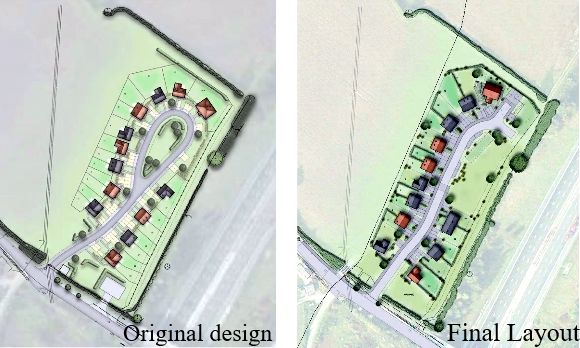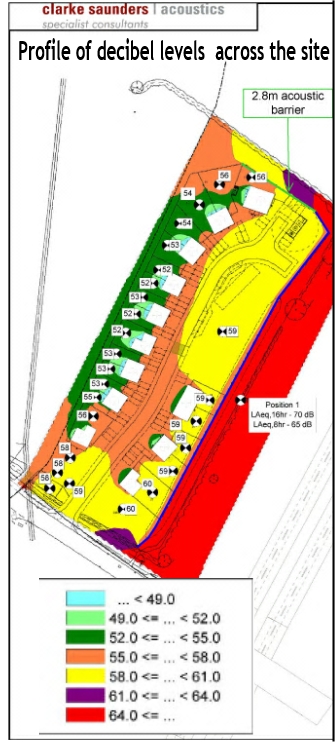Acceptance of the Feasibility Report and the under-pinning Phase 1 Technical Reports signalled the start of the Pre-Planning Application Phase. This is a recognised step in the Planning process, known as “Pre-App” where designers and planners can discuss outline ideas, gradually approaching a scheme that looks reasonable.
“Acceptance of Feasibility” meant that:
- Locality granted £40,000 on top of £10,000 already spent on the Feasibility Phase
- Parish Council released £4,000 from the Solar Fund to act as “match funding”
- Consultants were engaged (or re-engaged) to amplify the Phase 1 technical reports to “Final” standard i.e. to a quality which would stand scrutiny within the Full Planning Application.
- The architect had to continually modify the designs to reflect any findings in the Technical Reports as well as provide deeper levels of detail.
- Aster Group had to approve the business plan and provisionally allocate funds
- Legal documents to support the land sale and the 125-year lease between ECLT and Aster had to be drawn up.
Throughout the Pre Planning Application Phase the key officers in Stroud DC and Gloucestershire CC had to be kept up to speed with technical findings and consultation with Parish Council and all parishioners undertaken.
Outcome of Technical Reports
We knew from the Feasibility Report that several technical aspects were already non-contentious:
- Ecology – the site has always been an agricultural field
- Ground Survey – the Jurassic clay is well known to be stable, as the name implies
- Topographical Survey – originally done to top quality standards
- Air Quality – with 85% of winds being from the south-west, any pollutants from the motorway are actually blown towards Alkerton and away from the site
- Housing “mix” – the 23 homes had been agreed with Stroud DC and Parish Council to be:
- Four 1-bed flats
- Five 1-bed bungalows
- Three 3-bed semi-detached houses
- Eleven 2-bed semi-detached houses

Two significant areas remained tricky:
- the precise location of the underground service ducts and pipes. This in turn affected
- layout of the houses and roads
- access to the highway
- routing of drainage pipes and connection to sewer
- how the sound from the motorway could be mitigated, at what cost and again, how that might affect the housing layout
Underground Services and Acoustic Fencing
The Phase 1 Ground Penetrating Radar Survey had not been able to locate all the services. These were regional, rather than local pipes and ducts which each of the utilities insisted on plotting more accurately:
- National Gas pipeline – site visit undertaken but actually easily seen by marker poles
- Telephone Fibre duct – utility brought specialist equipment to the site and marked with pegs in the ground
- Trunk water main – this turned out to be a 500mm high pressure main, meaning that we could not build within 6 metres either side, rather than 3 metres each way expected by all other utilities
The fibre duct was further east than we had expected from historical plans and the utility would not allow us to have garden fences within 3 metres. This squeezed the houses closer to the motorway, changed the internal road design from a loop to a “J” shape and forced the highway exit to the east.
The high-pressure water main affected the number of houses we could plan on the motorway side and reduced the length of the acoustic berm (meaning a higher fence in the north-east).
The combined results meant that the layout changed from the Feasibility Report version (below left) to the December 2017 version displayed at the AGM (below right).


Acoustic Design was always in the mind of the architect: we had already agreed with Stroud DC to move 3 bungalows and the block of flats to the motorway side of the site for acoustic reasons.
Discussing the final acoustic design with the planners, it was agreed to have a one-metre high earth bund with a 2.5-metre acoustic fence on the motorway side.
Adjustment of the car spaces for plots 19 to 23 brought a “shadow” of quieter space in the front gardens for these houses whilst plots 1 to 18 had quiet areas in their back gardens. These “quieter” areas are below 55dBA, a World Health guideline.
Nationally, less than half our homes ever achieve this and our own measurements showed that very few places in Alkerton were ever below 60 dBA. People in Eastington know all about motorway noise
Legal Documents
By January 2018, all the technical hurdles have been passed and all that remains is to finalise three legal agreements:
- Sale of the land to ECLT for £1
- Payment of a Lease Premium by Aster to the landowner
- 125-year lease agreement between ECLT and Aster
The first two are included in a Conditional Contract between all three parties, where “conditional” essentially means dependant on planning permission. The third is what will govern ECLT’s relationship with Aster, both for the build phase (paid for by Aster, including grants) and the letting, maintenance and management of the site as 23 affordable homes to rent. Eastington homes for Eastington people
